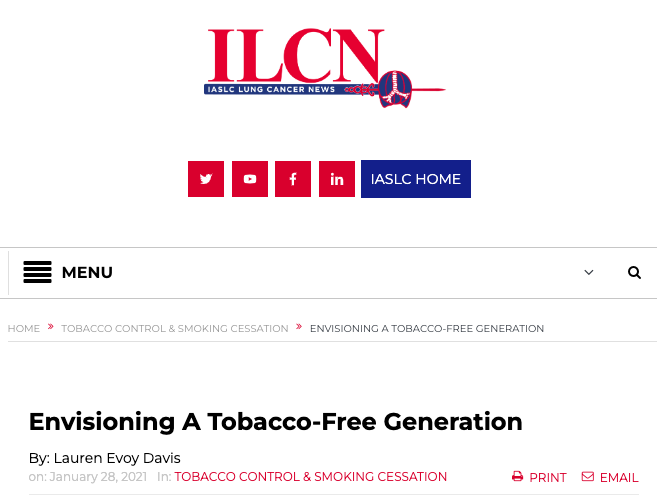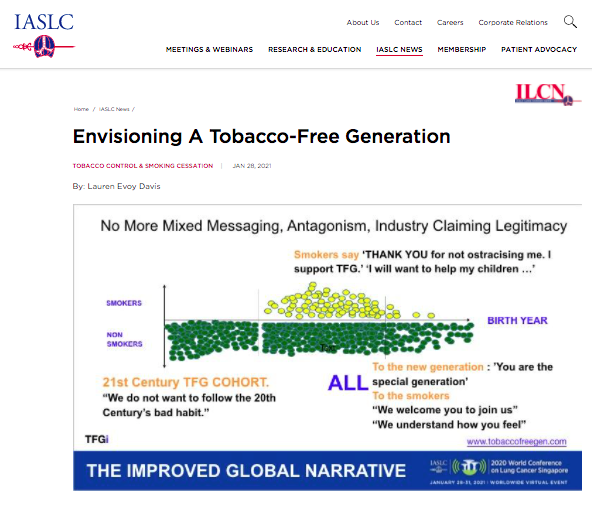
https://www.iaslc.org/iaslc-news/ilcn/envisioning-tobacco-free-generation
Million-dollar ad campaign characters such as the Marlboro Man and Joe Camel lured many people to take up the tobacco habit through magazine ads and TV commercials. Gimmicks such as “Camel Cash” that could be mailed in, in exchange for prizes such as cigarette lighters and t-shirts, made tobacco users walking advertisements, perpetuating an ethos of cool. Eventually, advertising standards were altered so as not to be so kid-friendly and enticing to young people.
Although ads to promote tobacco products have been curtailed during the past few decades, cancer from using tobacco products still kills more than 8 million people each year, according to the World Health Organization (WHO).1 It is also known that second-hand smoke is also dangerous and contributes to 1.2 million deaths around the world.
The challenge now is preventing future generations from ever becoming users.
Presenter Heng Nung Koong, MD, founder and director of the Tobacco Free Generation International, discussed this topic during the Education Session “The ‘How To’ of Modern Tobacco Control” (ES21). In 2010, Dr. Koong wrote a journal article, “Phasing-Out Tobacco: Proposal to Deny Access to Tobacco for Those Born from 2000” as a way to think about new generations of never smokers and how best stop them from ever becoming tobacco users.2 One way is to limit the supply and retail operations of tobacco and to create new policies around obtaining and publicly using tobacco in order to eradicate the initial desire or demand for tobacco products.
The ‘Tobacco Endgame’
Tobacco control researcher and policy analyst Ruth Malone, RN, PhD, FAAN, coined the term “tobacco endgame” in 2011 to propel tobacco-free priorities across the globe.
This Tobacco Endgame concept, “replaces the globally accepted, flawed minimum age [to legally purchase products]” Dr. Koong said. Children receive mixed messages; they are told about the dangers of smoking, and yet they see adults smoking. They are exploited by advertising, which promotes the idea that using these products makes one cool or glamorous. Teenagers, many of whom are eager to appear like adults, may engage in risky behaviors to be like the adults in their life and also their peers. The industry capitalizes on the rebellious psyche of teenagers by continuing to say that it only markets to adult smokers, leading many to accept the legitimacy of the industry and its claims.
Additionally, many young people do not suffer immediate health issues. The dangers of smoking increase over time, so many do not experience the health consequences until decades from their first cigarette, vape, or chew.
Improving Education
Saito et al,3 published in the British Medical Journal in 2013, an analysis of 40 textbooks that covered the dangers of tobacco usage and found that very few books presented ways to resist the allure of tobacco (Table).
The movement “needs to go beyond saying ‘smoking is bad and causes various diseases.’ Instead it is the peers who need to stand up in front of a group and advocate to thousands of children,” Dr. Koong said.
“It needs to be an ecosystem that gets permanent internalization in mass education in schools,” he added.
He suggested ways to accomplish this through positive peer pressure. Ideally, schools will develop youth leadership programs within education systems, especially targeting the teenage years, when youth are vulnerable and eager to fit in with peers.
Tobacco-Free Ordinances
As of 2015 in the Philippines, 23.8% overall (16.6 million adults; 41.9% of men and 5.8% of women), were current tobacco users.4)
Dr. Koong developed the world’s first tobacco-free ordinance in 2016 with the support of legislative leaders in the Philippines. In Balanga City, Bataan, the mayor approved this ordinance “as a novel preventive measure against tobacco abuse and tobacco’s harmful effects in the Philippines. It aims to regulate the sale of tobacco to any citizen born on or after January 1, 2000,” per the ordinance. The ordinance is being explored by the other municipalities within the province.
More recently, in November 2020, in Brookline Massachusetts, the Tobacco-Free Generation initiative was passed during a town meeting in a 139 (yes) to 73 (no) vote. This is the first initiative passed in the United States. This measure to prevent the sale of tobacco to anyone born on or after January 1, 2000, is awaiting approval from Massachusetts Attorney General Maura Healey.
These ordinances do not shame or condemn current tobacco users in any way. The idea is to prevent the next generation from starting in the first place.
“This is a phased-in, non-antagonist social movement that will result in no new smokers in future generations,” Dr. Koong said.
The hope is that this compelling initiative will catch on other states as well as globally. Currently more than 80% of the world’s 1.3 billion tobacco users live in low- and middle-income countries.1 To become sustainable as a country, inform your local municipalities and mayors on the Tobacco Free Generation merits. Get them to contact the Tobacco Free Generation team to start this better nicotine prevention ecosystem within your education system. The training workshops can be completed within 3-4 days.
For further information:
A related abstract (Abstract 1039), “Achieving the Tobacco Free Generation Endgame: #1 Reimagining the Implementation of Better Mass Tobacco Prevention Education,” was presented by Lynn Ong.
References:
- Tobacco. World Health Organization. https://www.who.int/news-room/fact-sheets/detail/tobacco. Published May 27, 2020. Accessed January 16, 2021.
- Khoo D, Chiam Y, Ng P, Berrick AJ, Koong HN. Phasing-out tobacco: proposal to deny access to tobacco for those born from 2000. Tob Control. 2010;19(5):355-360.
- Saito J, Nonaka D, Mizoue T, et al. Limited potential of school textbooks to prevent tobacco use among students grade 1–9 across multiple developing countries: a content analysis study. BMJ Open. 2013;3: e002340.
- Global Adult Tobacco Survey 2015. https://www.who.int/tobacco/surveillance/survey/gats/fact-sheet-2015.pdf. Published February 14, 2017. Accessed January 16, 2021.
Table.
| WHO Categories for Tobacco Prevention Education | Percentage of Topics Included in Text |
| Consequences of tobacco use | 73% |
| Not social norms | 46% |
| Reasons not to use tobacco | 10% |
| Social influences | 10% |
| Resistance and life skills | 1.2% |
